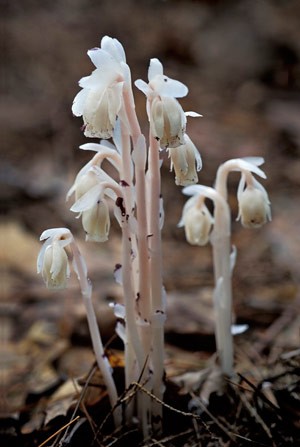An oddity in the plant world is the roughly one percent of plant species that do not manufacture their own carbohydrates via photosynthesis. Instead, these plants are parasites, stealing carbohydrates from other plants. Several of these unusual plants are found in the shade of the northern woodlands, and the most common and easily recognized is Indian pipe (Monotropa uniflora).
The name “Indian pipe” comes from the upside-down, pipe-like shape of the plant stem and its single, downturned, tube-shaped flower. The entire plant is a ghostly, waxy white or sometimes pinkish in color. This eerie coloration has given rise to another common name: corpse plant.
The flower stems of Indian pipe push through the duff of the forest floor in mid- to late summer, either singly or in small clusters. The virtually smooth stems, with tiny, vestigial leaves, grow to a height of 3 to 10 inches. The white pipes are conspicuous in the dense forest shade and grow where the light is too dim for most other plants to survive. Not much is known about the pollination of Indian pipe’s flowers, but the plant does produce copious, dust-like seeds. Upon fertilization, the downward-pointing flower turns upward, which is the reason behind the plant’s genus name of Monotropa, meaning “one turn.” After the seeds mature, the entire plant turns black but remains upright for up to several weeks.
Since Indian pipe does not photosynthesize, it does not need chlorophyll and so has no green coloration. It does not need leaves to gather sunlight, nor does it even need sunlight. What it does need, however, is to have its roots connected with an underground, mycorrhizal fungus that, in turn, is connected to the roots of a living tree. Symbioses between mycorrhizal fungi and photosynthesizing plants, like trees, are common. The tree’s roots gather water and nutrients from the soil by way of the fungus, and the fungus takes carbohydrates that the tree has produced with energy from the sun. It is a mutually beneficial relationship. Indian pipe is an interloper in this symbiosis – stealing the tree’s carbohydrates from the fungus and giving nothing in return. Many scientists therefore consider Indian pipe to be a parasite of the fungus.
Indian pipe is a member of the heath (Ericaceae) family, along with mountain laurel, blueberry, and trailing arbutus. Scientists believe that Indian pipe descended from a photosynthesizing heath family plant of the forest understory. This ancestor plant probably shared the services of a mycorrhizal fungus with a tree, possibly a conifer. The ancestor plant was very efficient at tapping into the resources of the mycorrhizal fungus and began to confiscate the carbohydrates that the fungus had obtained from its conifer host. The ancestor plant became so efficient at stealing carbohydrates from the fungus that it no longer needed to photosynthesize. Over time, it lost its green coloration and its leaves and evolved into today’s Indian pipe.
Although Indian pipe produces many seeds, few seeds will germinate and grow on to become mature plants. This is because the dust-like seeds need very exacting conditions for germination and growth, including contact with the appropriate mycorrhizal fungus. Because Indian pipe is slow to establish from seed and thrives in deep shade, it is most often seen in older forests, especially those with rich soils.



Discussion *